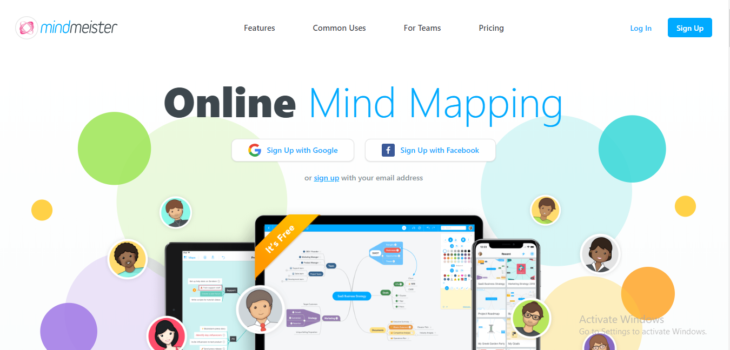Mind mapping is a technique that has been widely used all across the globe over the centuries to visually represent ideas and thoughts while allowing participants to brainstorm. This technique is an effective method for discussing topics that demand creativity and active engagement. Brainstorming has been used successfully in teaching practices and businesses.
Mind mapping has traditionally been done manually with papers or writing boards, but recently, many tools such as mindomo for making a Mind map online have been developed to make things a lot easier and convenient. Collaborative online mind mapping is an excellent way to make decisions, organize information, and make collective plans. The fact that the platform is online makes it possible to share mind maps with other members, colleagues, and friends.
Contents
Making an online mind map

Source: timeterminator.com
-
Begin in the middle
A mind map starts in the center and pans outwards. In the center will be the topic under discussion which could be written in the form of a keyword, question, image, or a problem. The central idea can use images or colors that represent the topic under discussion in order to trigger associations.
-
Add branches
From the title in the center of your digital canvas, branches will extend outwards to write the key ideas about your subject. These will be represented with 4 to 6 branches panning out from the center.
-
Add keywords on the branches
These keywords will represent the key ideas under discussion so remember to keep them compact and precise. Looking at these will give you an instant preview of the important points regarding the topic.
-
Color code the branches
Mind maps are known to promote activity in a number of parts of the brain and an overlap of various skills. Color coding your mind maps is one-way such thinking can be promoted further. Such coding is known to create a link between logical and visual elements, and subsequently create mental shortcuts known as heuristics. Doing so can help create more connections in the brains and analyze information better to reach more logical conclusions.
-
Start adding ideas
Once your base is set, start adding ideas under the keyword branches. One point can lead to further ideas that can be added in the form of child branches panning out from the ideas. You can create as many hierarchical levels and branches as you want.
-
Add visual elements
You can make your mind map much more creative and interesting by adding visuals like colors, images, icons, etc. Certain online mind mapping tools also allow you to include videos, comments, notes, and even spreadsheets or PDF files.
Benefits of mind mapping

Source: pexels.com
Compared to traditional techniques of note-taking and writing, making mind maps is a much more creative and beneficial method of discussing ideas.
-
Mind maps help organize and structure information
Mind maps are known to organize information by reducing chaos and bringing together ideas. As graphical representations, mind maps can help users understand the relationship between complex ideas and see the bigger picture.
-
Mind maps are known to improve memory of the ideas being discussed
Since mind maps trigger a number of brain processors, related to images and colors, for example, they improve information retention. Such triggers are easier to remember than textual information.
-
Mind maps enable creative thinking
Mind maps are known for their ability to encourage creativity by their use of keywords and images that help create active associations. The information displayed in such a way increases transcribing speed and enables creativity.
-
Online mind maps allow you to collaborate with other participants in real-time
With online mind mapping tools, you can collaborate with a number of other participants in real-time and brainstorm with people from anywhere across the globe. With online mind maps, there are no geographic limitations. Regardless of one’s location or device being used, anyone can join in the discussion in real-time.
Uses of online mind maps for teaching

Source: blog.commlabindia.com
-
Revision and note-taking
Teachers usually need to sum up a topic either at the beginning of a topic or at the end of a topic as a review. With mind maps, teachers can easily overview a topic and share the mind map with their students. The students can also then elaborate on the mind map for their own use; for revising later, for example.
-
Creating presentations for lectures
An overview mind map can be created for new topics and then made into a slideshow to make learning more interesting. These mind maps can also include links or websites and then be presented during class.
-
Monitoring participation of individual students
Online mind mapping tools usually enables participants to access change history. This feature can be used by teachers to track the performance and involvement of their students individually and trace their thought processing.
-
Writing and research
Mind maps are the perfect tools for brainstorming before elaborating on the topic. Individual students can also export their mind map outlines and then use this for further elaboration.
-
Overcoming learning disabilities
Usually, students with learning disabilities like High-functioning autism and dyslexia face extreme difficulty adapting to the traditional classroom setup. The visual depictions in mind maps can prove very beneficial for such students and make learning more effective for them.
Who can benefit from mind maps?

Source: pexels.com
-
People in creative professions
Marketing professionals, writes, and designers, like other similar streams of work, are constantly involved in generating new idea,and using mind maps is the ideal way to brainstorm suggestions and reach effective conclusions.
-
Managers
Managers are involved in complex decision making, outlining meetings, planning projects, and much more. They can benefit from the use of mind maps to make these activities much simpler.
-
Advisors
Advisors and consultants can use mind maps to convey their ideas efficiently to their clients and improve communication.
-
Teachers
As mentioned before, mind maps are wonderful tools in the classroom. Teachers can use these to encourage collaboration and critical thought while discussing topics.
-
Students
Students can immensely benefit from the use of mind maps in making lecture notes for later revision and overviews. These offer a great way of improving memory of the concepts.
Online mind mapping is a strategy used by people from various backgrounds all across the globe and has so far proven to be one of the most effective techniques ever used.
